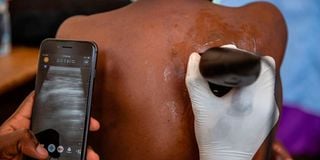Pneumonia still leading killer of children in the country, says government

A clinical officer checks a patient for pneumonia using a Butterfly IQ ultrasound scanner.
Narok, Samburu, West Pokot, Marsabit and Mandera recorded very high cases of pneumonia in the past 12 months, while Kericho, Kisumu, West Pokot, Laikipia, Samburu, Kitui, Nyeri, Nairobi and Uasin Gishu registered the highest neonatal deaths, according to the Ministry of Health.
This emerged during the commemoration of this year’s child health days (World Pneumonia and World Prematurity days) by the ministry on Thursday.
While disclosing that it has been recording a total of 900 neonatal deaths a month, the government explained that despite numerous interventions together with partners, pneumonia remained a nightmare to thousands of Kenyan children under the age of five, with only 33 percent getting the appropriate antibiotics.
“World Pneumonia Day reminds us of the efforts the government has put in place to address pneumonia, which is a leading killer in under-fives, contributing to the deaths of around 9,000 under-fives in 2018,” said Dr Andrew Mulwa, the director of Medical Services, Preventive and Promotive Health at the ministry.
Dr Mulwa disclosed what interventions the government has put in place.
“To ensure improvement of under-five outcome, uptake of oral rehydration salts (ORS) and zinc for management of diarrhoea in children under five, improved exclusive breastfeeding, introduction of new childhood vaccines like pneumococcal and rotavirus, advocacy to ensure availability of essential medicines in the facilities and strengthening community inventions to ensure early health seeking behaviour,” the director listed.
There was, however, a sharp decline in pneumonia treatment in the country from March 2020 to September 2020 due to the emergence of Covid-19.
The government notes that there was a marked decline in the number of children treated for pneumonia in health facilities, but the trends among children under five have been steadily increasing.
According to the Health ministry, while Kenya has made significant progress since 1990, 60,000 children under the age of five died in the country in 2018.
“The leading causes of child morbidity and mortality are familiar and are pneumonia (15 per cent), diarrhoea (11 per cent), malaria (4 per cent), HIV (4 per cent) and other non-communicable diseases (26) per cent,” the ministry highlighted.
It further explained that 75 per cent of the deaths occur during the first year of a child’s life, while 48 per cent happen during the first month (neonatal) period.
Dr Caroline Mwangi, the head of division, Neonatal and Child Health said the team envisions a Kenya where all newborns survive, thrive and live to their fullest potential.
“The current interventions to address neonatal and child health mortality and morbidity include focus on the new-born through implementation of high-impact interventions, which are cost effective, introduction of a nurturing care framework aimed at supporting responsive caregivers during early years of childhood, supporting counties to provide commodities and equipment to manage common paediatric conditions (for example pneumonia and diarrhoea for favourable outcomes, supporting community identification and management of common childhood illness with referral of sick children with danger signs to the nearest health facility for management and programming for children with special needs, no child should be left behind,” she said.
The ministry also disclosed that care seeking for acute respiratory infection is still low, at 67 percent, with most of the caregivers seeking care when it is too late to save the sick child.
“In 2020, Kenya signed the declaration to end pneumonia deaths in children under five years, the pneumonia guidelines recommend treatment using high dose amoxicillin dispersible tablets, the doses increased the coverage of children,” it said.
Dr Bashir Isaak, the ministry’s head of the Family Health Division, told the Nation that neonatal mortality contributes to around 47 per cent of the under-five mortality, with intrapartum complications, prematurity and sepsis as the leading causes.
“Statistics still put us on the list of shame as pneumonia is one of the leading causes of death in children despite being easily preventable and treatable.
Every year in Kenya it is estimated that 134,500 babies are born preterm -- that is below 37 weeks -- while close to 14,000 die due to preterm birth-related complications and this is why Kenya is among the top 15 countries with the highest rates of premature births out of 188 countries,” he said.
The expert points out that globally, an estimated 2.5 million newborns died in the first month of life in 2018, about 8,000 every day.
Dr Mulwa said Kenya’s 2020 signed declaration to end pneumonia committed to develop a costed pneumonia control strategy whose development he says is on course.
This year’s theme is ‘Zero Separation Act Now! Keep parents and babies born too soon together’.
The director further discloses that improvement for Kenya’s newborn health has not kept pace with progress for older children and accounting for a disproportionately high number of under-five deaths.
“Among the newborns who die, 50 per cent die on the day of their birth and 75 per cent in the first 28 days of life, with major causes of deaths being intrapartum related events (birth asphyxia), prematurity and sepsis. This trend calls for high impact interventions such as Kangaroo Mother Care to all counties, use of chlorhexidine digluconate 7.1 percent gel for newborn umbilical cord care in the country and effective management of labour and delivery,” Dr Mulwa highlighted.





